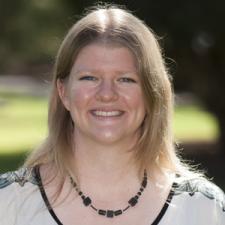Rebecca Lybrand - 2014 CLIMAS Climate & Society Graduate Fellow
 To Rebecca Lybrand, calling soil “dirt” is simplistic and diminishes its importance to plants, animals, and human beings. So why is soil, the foundation of life, constantly being referred to as “dirt?” Rebecca began this line of thinking in college, and this spark of curiosity turned a simple question into a career.
To Rebecca Lybrand, calling soil “dirt” is simplistic and diminishes its importance to plants, animals, and human beings. So why is soil, the foundation of life, constantly being referred to as “dirt?” Rebecca began this line of thinking in college, and this spark of curiosity turned a simple question into a career.
Rebecca is now a soil scientist at The University of Arizona. She received her Ph.D. from The University of Arizona’s Department of Soil, Water and Environmental Science (SWES) in 2014. She is also a recipient of the 2014 Climate Assessment for the Southwest (CLIMAS) Climate & Society Graduate Fellowship.
Rebecca’s CLIMAS project centered on creating two short films that documented her research across the Santa Catalina Mountains in Arizona. These films showcase four of her field sites, which span over 4000 feet of elevation gain. The sites differ in temperature, precipitation, and vegetation, all of which have remarkable impacts on the characteristics of these soils.
The visuals for both films are the same, but the scripts change to present the science message in two different contexts. One uses a lively, first person perspective that relays a scientific story, using Rebecca’s personal experience to frame the film. The other is in third person, and presents a formal video delivering a more scientific message along the lines of what you might see in a science documentary. The main objective of this project is to survey students and to evaluate the effectiveness of formal and informal communication techniques.
Rebecca had been interested in doing this project for quite some time. The year before she was a CLIMAS C&S graduate fellow, she was part of the Carson Scholars program, where she learned more about how to communicate science effectively. As a Carson Scholars Fellow, Rebecca saw the potential for making a soils video and even connected with Dr. Jay Hmielowski, an assistant professor specializing in Environmental Communication, who was willing to collaborate on the project. However, at the time, Rebecca was a graduate student and did not have a lot of free time or extra funding available to make the video happen.
In the back of Rebecca’s mind she knew that she wanted to make this video. She went out in the field to shoot footage and she even began to make connections with a local media and communications expert, all before learning about the CLIMAS fellowship.
“Seeing the CLIMAS announcement and completing the proposal process is what solidified it,” said Rebecca. “The CLIMAS fellowship made this outreach project happen.”
Rebecca didn’t have much experience with shooting footage or editing video prior to working on this project. Her inspiration actually came from mountain biking. Both she and her fiancé mountain bike, and enjoy using a GoPro camera to film their adventures on the trails. Moreover, they are avid fans of attention-grabbing, professionally produced mountain biking documentaries.
“I always thought that the videos were really engaging and even people who don’t mountain bike enjoy watching them,” said Rebecca. “I kept thinking, this is the way to present science, in a fun and interactive way.”
Because Rebecca had little experience with making a film, she reached out to Shipherd Reed, the Marketing and Communications Manager at the UA Flandrau Science Center. Shipherd helped Rebecca along the way with things such as how to capture footage and how to navigate Final Cut Pro. Rebecca says he was very willing to help and extremely patient.
Because Rebecca had never edited video before, her main challenge was that everything took much longer than she anticipated. She had captured hours of video and then watched every second of it, taking notes along the way.
“In my proposal I put together my nicely framed timeline, which was completely unrealistic,” said Rebecca. “Every step took hours, days or even months longer than I had planned on, but it was worth it.”
Difficulties aside, Rebecca made great memories putting this film together. On the longest day of shooting, Rebecca and her fiancé were on the road to a field site before the sun rose and were hiking back from another field site as the sun went down.
“We reflect back on that day and laugh. I know that we were both exhausted by the time we got home, but it was a really fun and exciting day,” said Rebecca. “We also saw a Gila monster, so that was an added reward because I love reptiles.”
Now that both videos are complete, Rebecca has teamed up with her collaborator, Dr. Hmielowski, to write and carry out student pre-tests and surveys to test the effectiveness of the contrasting narrative strategies. Rebecca hopes to present the study at a science communication conference with the ultimate goal of publishing her findings to reach a larger audience.
Rebecca is now working on her Postdoc with Dr. Rachel Gallery’s soil microbial ecology research group. She is looking at how soils and topography are impacting soil microbes across pine beetle- and fire-disturbed environments in Colorado. Rebecca intends to continue working as a soil scientist and plans to maintain her science outreach work in the community. She knows that having this readily available video and the skills required to produce more videos will help her in the future.
“Everyone is always interested in the different types of outreach work that you do and in knowing that you are able to communicate to interdisciplinary teams of scientists and the public,” said Rebecca. “Having this real concrete visual representation of my research is a great product.”

